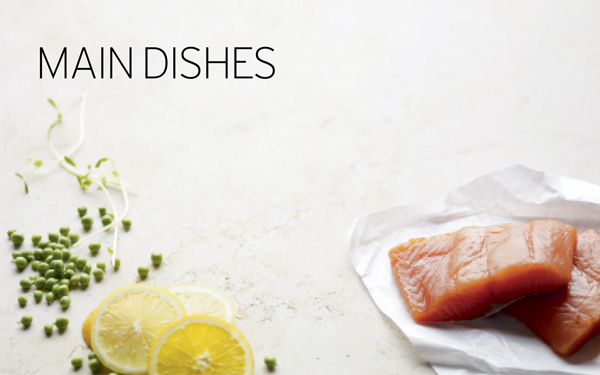
poached salmon with asparagus, herbs, and baby greens
roasted salmon and parsnips with ginger
curry-rubbed salmon with napa slaw
citrus-roasted salmon with spring pea sauce
miso salmon with cilantro sauce
hoisin-glazed sablefish with bok choy
sablefish en papillote with shiitake mushrooms and orange
panfried trout with almonds and parsley
halibut in green-tea broth with quinoa
shrimp with kiwifruit-lime relish
brown rice with tofu, dried mushrooms, and baby spinach
vegetable-rice bowl with miso dressing
whole-wheat pizza with artichokes and pecorino
stuffed poblanos in chipotle sauce
whole-wheat spaghetti with herb-almond pesto and broccoli
soba noodle, tofu, and vegetable stir-fry
whole-wheat pasta with lentils, spinach, and leeks
spinach pasta with corn, edamame, and green beans
swiss chard, mushroom, and quinoa salad
walnut-crusted chicken breasts
chicken breasts with fennel, carrots, and couscous
chicken with pumpkin-seed mole
lemon chicken with avocado-corn salsa
turkey cutlets with tomatoes and capers
grilled pork tenderloin and apricots with honey glaze
pork tenderloin with sautéed beet greens and roasted beets
steak with spicy papaya-carrot salsa
grass-fed beef stir-fry with broccoli
Poached Salmon with Asparagus, Herbs, and Baby Greens

SERVES 4
This basic poaching recipe yields salmon that can be served warm, at room temperature, or chilled. Here, salmon and a few hard-cooked eggs provide protein to a colorful salad composed of fresh vegetables and mixed herbs from the farmers’ market.
1 skin-on wild Alaskan salmon fillet (about 1½ pounds and 1 inch thick)
½ teaspoon finely grated lemon zest, plus ⅓ cup plus 2 tablespoons fresh lemon juice (from about 4 lemons)
Coarse salt
1 bunch medium-thick asparagus (about 1 pound), tough ends trimmed
1 shallot, thinly sliced into half moons
½ teaspoon finely grated orange zest plus 1 tablespoon fresh orange juice
2 teaspoons champagne vinegar
¼ cup extra-virgin olive oil
4 cups mixed baby greens, such as spinach and tatsoi
¼ cup mixed fresh herb leaves, such as mint, basil, and tarragon
12 radishes, trimmed and halved
4 hard-cooked eggs, peeled and halved lengthwise
1 Fill a saucepan wide enough to hold salmon with 2 to 3 inches cold water. Stir in ⅓ cup lemon juice and 2 teaspoons salt. Bring to a boil; reduce heat to a simmer and gently place salmon in pan, skin side down. Reduce heat and cook at a bare simmer until salmon is just opaque throughout, 10 to 12 minutes. Transfer to a plate. Cover loosely with a piece of parchment paper to prevent surface from drying, and let cool 20 to 30 minutes. Once cool, salmon can be refrigerated, covered tightly with plastic wrap, for up to 2 days.
2 Bring a pot of water to a boil and prepare an ice-water bath. Blanch asparagus until crisp-tender and color brightens, 45 to 60 seconds. With a slotted spoon, immediately transfer asparagus to ice-water bath to stop the cooking; once cool, drain and pat dry with paper towels.
3 Combine shallot, lemon and orange zests, 2 tablespoons lemon juice, the orange juice, vinegar, and ¼ teaspoon salt in a small bowl. Gradually whisk in the olive oil until emulsified.
4 Assemble asparagus, greens, herbs, radishes, and eggs on a platter. Break salmon into large pieces, arrange on top, and drizzle with vinaigrette. Serve immediately.
per serving: 480 calories; 5.3 g saturated fat; 22.7 g unsaturated fat; 306 mg cholesterol; 7.9 g carbohydrates; 42.2 g protein; 303 mg sodium; 3 g fiber

Roasted Salmon and Parsnips with Ginger

SERVES 4
The flavorful ginger dressing that coats the parsnips calls for tamari, a sauce made from soybeans that’s darker and richer than conventional soy sauce (it’s also gluten free). Serve the fish with a wedge of orange along with peppery greens, such as watercress or arugula.
1 pound parsnips (about 5), peeled and sliced ¾ inch thick
3 tablespoons neutral-tasting oil, such as canola or safflower
2 teaspoons finely grated peeled fresh ginger
2 teaspoons finely chopped fresh rosemary
2 tablespoons low-sodium tamari soy sauce
¼ cup plus 2 tablespoons fresh orange juice (from 1 to 2 oranges)
4 skinless wild Alaskan salmon fillets (about 6 ounces each)
1 Preheat oven to 425°F. Place parsnips on a rimmed baking sheet and drizzle with 2 tablespoons oil; toss to coat, then spread in a single layer. Roast until beginning to brown around the edges, about 15 minutes. Meanwhile, combine ginger, rosemary, tamari, orange juice, and remaining 1 tablespoon oil.
2 Flip parsnips and push to edges of baking sheet. Place fillets in the middle. Cook, flipping halfway through, until fillets are opaque around the edges and flake slightly in center when pressed, 12 to 15 minutes. Remove from oven.
3 Transfer a fillet to each of four plates. Pour ginger mixture over parsnips and gently toss to coat. Divide parsnips among plates. Spoon extra sauce from baking sheet over fish and parsnips, and serve.
per serving: 458 calories; 1 g saturated fat; 13 g unsaturated fat; 107 mg cholesterol; 21 g carbohydrates; 41 g protein; 598 mg sodium; 5 g fiber

Curry-Rubbed Salmon with Napa Slaw

SERVES 4
Broiling is a good way to brown the salmon without adding fat. For a golden color and crisp finish, don’t turn the fish while it is under the broiler; it will still cook all the way through without this extra step.
2 cups water
1 cup brown basmati rice
Coarse salt and freshly ground pepper
½ head napa cabbage (1 pound), thinly sliced crosswise
1 pound carrots, peeled and coarsely grated
½ cup loosely packed fresh mint leaves
¼ cup fresh lime juice (from 2 to 3 limes), plus lime wedges for serving
2 tablespoons grapeseed oil
4 skinless wild Alaskan salmon fillets (about 6 ounces each)
2 teaspoons curry powder
1 In a large saucepan, bring the water to a boil; add the rice and ½ teaspoon salt. Cover and reduce heat to medium-low. Cook until rice is tender and has absorbed all liquid, 30 to 35 minutes. Remove from heat; let stand, covered, 10 minutes.
2 Meanwhile, in a large bowl, combine cabbage, carrots, mint, lime juice, oil, and ½ teaspoon salt; season with pepper. Toss to combine.
3 Heat broiler, with rack set 4 inches from heat source. While rice is standing, place salmon on a broiler pan or rimmed baking sheet. Rub fillets with curry powder and ½ teaspoon salt, dividing evenly; season with pepper. Broil until just cooked through, 6 to 8 minutes.
4 Divide salmon and cabbage mixture among four plates. Fluff rice with a fork and serve alongside.
per serving: 583 calories; 6 g saturated fat; 18.3 g unsaturated fat; 85 mg cholesterol; 47.2 g carbohydrates; 39.8 g protein; 1140 mg sodium; 7.3 g fiber

Citrus-Roasted Salmon with Spring Pea Sauce

SERVES 8
Salmon seasoned with orange, lemon, and lime contrasts beautifully with a fresh-pea puree. Green peas—actually legumes, not vegetables—are high in protein and vitamin K, which boosts bone health.
3 oranges
3 lemons
Freshly grated zest of 1 lime
2 teaspoons sugar
Coarse salt and freshly ground white pepper
1 teaspoon coriander seeds, crushed
1 side of wild Alaskan salmon (about 3 pounds), trimmed of fat and excess skin, small pin bones removed with tweezers
2 tablespoons extra-virgin olive oil
Spring Pea Sauce (see below)
Pea shoots or watercress, for garnish
Finely grate the zest of 2 oranges and 2 lemons. Cut the remaining orange and lemon into ¼-inch-thick rounds. Stir together citrus zests (including lime), sugar, 2 teaspoons salt, 1½ teaspoons pepper, and the coriander in a small bowl.
Place salmon, skin side down, in a nonreactive (glass or ceramic) baking dish large enough for it to lay flat. Rub spice blend all over salmon. Cover with plastic wrap. Refrigerate 2 hours.
Remove salmon from refrigerator. Wipe off spice blend with paper towels. Let fish stand at room temperature 20 minutes. Meanwhile, preheat oven to 400°F.
Arrange half the orange and lemon rounds in a single layer in a large roasting pan; place salmon, skin side down, on top. Rub the oil all over salmon. Roast until opaque throughout, about 17 minutes. Remove from oven; cut salmon crosswise into 8 pieces.
To serve, divide sauce among eight serving plates, and top each with a piece of salmon. Garnish with pea shoots and remaining orange and lemon rounds.
per serving: 432 calories; 4.9 g saturated fat; 13.4 g unsaturated fat; 109 mg cholesterol; 16.2 g carbohydrates; 36.8 g protein; 686 mg sodium; 3.6 g fiber
MAKES ¾ CUP
You can make this sauce with thawed frozen peas instead of fresh, in which case they don’t need to be blanched.
1⅓ cups shelled fresh peas
1½ cup loosely packed trimmed watercress (½ bunch)
1½ tablespoons cold unsalted butter, cut into small pieces
Coarse salt
Prepare an ice-water bath. Bring a pot of water to a boil. Blanch peas and watercress until bright green, about 45 seconds. Immediately transfer with a slotted spoon to the ice bath to stop the cooking.
Drain peas and watercress, then puree in a blender until smooth, adding 4 to 5 tablespoons water to thin (mixture should be just thick enough to coat the back of a spoon). Pass puree through a fine sieve into a small saucepan. Place over low heat, and whisk in butter, 1 piece at a time; whisk until emulsified, then remove from heat. Season sauce with ½ teaspoon salt (or to taste). Serve warm.
per serving: 37 calories; 1.2 g saturated fat; .6 g unsaturated fat; 5 mg cholesterol; 3.5 g carbohydrates; 1.4 g protein; 123 mg sodium; 1.2 g fiber
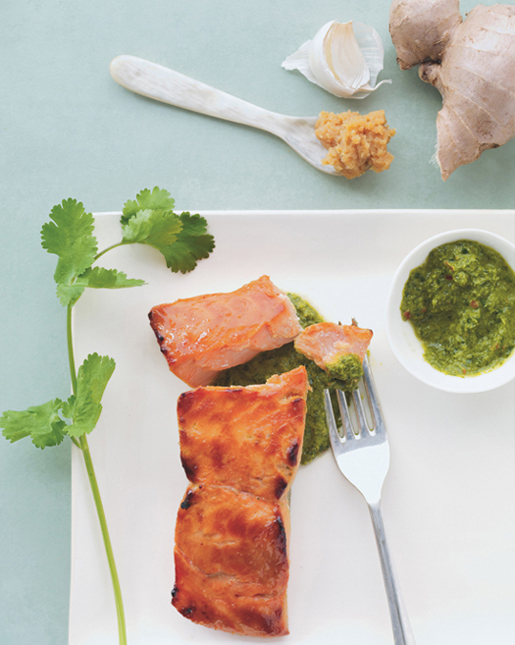
Miso Salmon with Cilantro Sauce

SERVES 4
Miso, a combination of fermented soybeans and rice or barley, is a great source of zinc, a natural immunity booster. White miso has less sodium than other types; here, it’s combined with rice vinegar, brown sugar, and water to make a marinade for salmon. Cilantro, ginger, and chile (along with a few other ingredients) are quickly pureed into a sauce for the broiled fish. Serve with brown rice or soba (buckwheat) noodles.
1 cup white miso
⅓ cup rice vinegar (unseasoned)
¼ cup packed dark brown sugar plus 1 teaspoon
⅓ cup water
4 skinless wild Alaskan salmon fillets (about 6 ounces each)
1 cup packed cilantro leaves, coarsely chopped
¼ cup fresh lime juice (from 2 to 3 limes)
1 shallot, coarsely chopped
1 small fresh red chile, such as Thai bird or jalapeño, coarsely chopped (ribs and seeds removed for less heat, if desired)
1 garlic clove
1 piece (2 inches) fresh ginger, peeled and finely grated (1 tablespoon)
2 tablespoons neutral-tasting oil, such as canola or safflower
1 In a medium saucepan, combine miso, vinegar, ¼ cup brown sugar, and the water. Cook over medium heat, stirring occasionally, just until miso and sugar have dissolved (do not boil); remove from heat, and let cool to room temperature.
2 Place salmon in a shallow dish or a resealable plastic bag, and add miso mixture, turning to coat. Cover (or seal) and marinate in the refrigerator 1 hour (place bag on a plate in case of leaks).
3 Meanwhile, puree cilantro, lime juice, shallot, chile, garlic, ginger, oil, and remaining teaspoon brown sugar in a blender until sauce is smooth.
4 Heat broiler with rack 6 to 8 inches from heat source. Lift fillets from marinade and wipe off excess (discard marinade); broil until fillets are opaque around edges and flake slightly in center when pressed, 4 to 6 minutes. Transfer salmon to each of four plates, and serve with cilantro sauce.
per serving: 500 calories; 2.2 g saturated fat; 16.2 g unsaturated fat; 94 mg cholesterol; 40.6 g carbohydrates; 39.5 protein; 1964 mg sodium; 0 g fiber

Hoisin-Glazed Sablefish with Bok Choy

SERVES 4
Sablefish, also known as black cod, is among the best sources of heart-friendly omega-3 fatty acids. Here, the fish is combined with bok choy, which contains antioxidants and fiber. The hoisin mixture, brushed on top of the fish before broiling, is essentially a quick barbecue sauce.
2 tablespoons neutral-tasting oil, such as canola or safflower
1 piece (3 inches) fresh ginger, peeled, thinly sliced, and cut into very thin matchsticks
3 garlic cloves, thinly sliced
1 head bok choy (1½ pounds), trimmed and sliced crosswise into 1-inch-wide pieces, greens and stalks separated
2 celery stalks, quartered lengthwise and cut crosswise into 2-inch lengths
Coarse salt and freshly ground pepper
1 bunch scallions, trimmed and cut into 2-inch lengths
3 tablespoons hoisin sauce
1 tablespoon ketchup
1½ teaspoons Dijon mustard
1 teaspoon fresh lemon juice
4 skinless sablefish fillets (about 5 ounces each)
1 In a large saucepan, heat the oil over medium. Add ginger and garlic; cook, stirring, until fragrant, about 1 minute. Add bok choy stalks, celery, and ½ teaspoon salt; season with pepper. Cook, stirring frequently, until crisp-tender, 5 to 7 minutes. Add scallions, and cook, stirring, until wilted, about 3 minutes.
2 Heat broiler with rack 4 inches from heat source. Stir together hoisin, ketchup, mustard, and ½ teaspoon lemon juice. Place fish on a broiler pan or rimmed baking sheet. Season on both sides with ½ teaspoon salt, dividing evenly, and pepper. Brush tops with hoisin mixture. Broil until fish is glazed and opaque throughout, 5 to 7 minutes.
3 Add remaining ½ teaspoon lemon juice to bok choy greens; spoon onto four plates and top each with a fish fillet. Serve immediately.
per serving: 400 calories; 5.2 g saturated fat; 20.8 g unsaturated fat; 70 mg cholesterol; 12.3 g carbohydrates; 22.4 g protein; 968 mg sodium; 2.6 g fiber
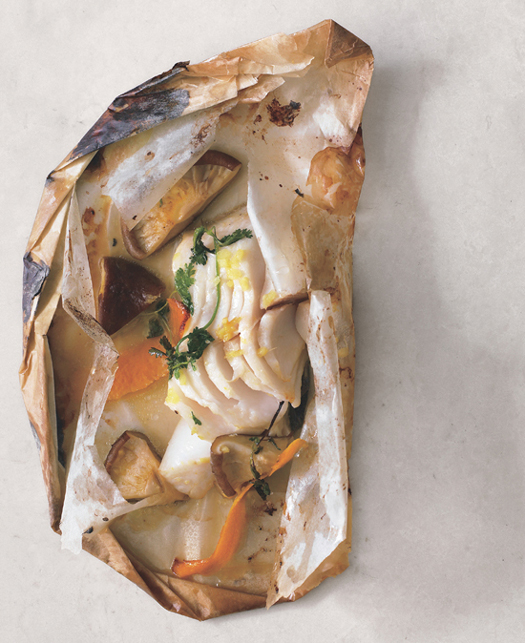
Sablefish En Papillote with Shiitake Mushrooms and Orange

SERVES 4
Sablefish’s succulent texture and high oil content make it an exceptional choice for steaming. In this recipe, the fish is steamed in parchment-paper packets (en papillote), which seal in moisture and flavor.
1 navel orange
4 skinless sablefish fillets (about 5 ounces each)
Coarse salt and freshly ground pepper
2 teaspoons minced peeled fresh ginger
1 tablespoon plus 1 teaspoon extra-virgin olive oil
12 fresh shiitake mushrooms, stems removed, caps cleaned and halved
24 cilantro sprigs
1 Preheat oven to 425°sF. Use a vegetable peeler to remove 8 strips of orange zest, leaving bitter white pith behind. Halve the orange and extract the juice. Cut out four 15-inch squares of parchment paper; fold each in half to make a crease, then open again. Place a fillet on one half of each parchment. Season all fish on both sides with 1 teaspoon salt, dividing evenly, and pepper; sprinkle with ginger, and drizzle with oil and juice. Arrange 2 zest strips, 6 shiitake pieces, and 6 cilantro sprigs on top of each fillet.
2 Fold parchment over fish, and crimp the edges to form a half-moon shape, pleating repeatedly all the way around to seal. Place packets on a baking sheet and cook until paper puffs up, about 10 minutes. Remove from oven; place packets on plates, and serve immediately, cutting them open at the table.
per serving: 352 calories; 5.2 g saturated fat; 18.4 g unsaturated fat; 69.5 mg cholesterol; 6.9 g carbohydrates; 20.9 g protein; 564 mg sodium; 1.2 g fiber


SERVES 4
Fresh herbs are a healthy way to season fish and other lean proteins. Here, pungent oregano and bright lemon juice balance the richness of the trout. The whole trout are grilled in this recipe, but you can use the broiler instead; lightly coat the broiler pan or a rimmed baking sheet with oil before heating, and cook the fish for the same amount of time.
2 tablespoons neutral-tasting oil, such as canola or safflower, plus more for grill
4 whole trout (about 12 ounces each), preferably U.S. farmed, cleaned and scaled
Coarse salt and freshly ground pepper
2 lemons, 1 sliced into 8 rounds, 1 cut into wedges for garnish
1 large bunch oregano
1 Heat a grill to medium-high (if using a charcoal grill, coals are ready when you can hold your hand 5 inches above grate for just 4 to 5 seconds); brush grates with oil. Sprinkle exterior and cavity of each fish with ¼ teaspoon salt, and season with pepper. Tuck 2 lemon rounds and a few oregano sprigs in cavity of each fish.
2 Rub each fish with ½ teaspoon oil, and place on grill. Cook until golden and firm, about 4 minutes per side. Transfer to a serving platter; drizzle each fish with 1 teaspoon oil. Garnish with lemon wedges and remaining oregano, and serve.
per serving: 382 calories; 1.3 g saturated fat; 6.7 g unsaturated fat; 0 mg cholesterol; 12.4 g carbohydrates; 54 g protein; 123 mg sodium; 5.4 g fiber

Panfried Trout with Almonds and Parsley

SERVES 4
Chopped almonds contribute substantial fiber, calcium, potassium, and zinc to simply prepared trout fillets. For a light supper, serve the fish with baby lettuce leaves and lemon wedges for squeezing over the dish.
1 tablespoon plus 2 teaspoons neutral-tasting oil, such as canola or safflower
4 skin-on trout fillets (preferably U.S. farmed)
Coarse salt and freshly ground pepper
3 ounces raw whole almonds, coarsely chopped
1 cup loosely packed fresh flat-leaf parsley leaves, coarsely chopped
Finely grated zest plus freshly squeezed juice of 2 lemons
1 Heat 1 teaspoon oil in a large skillet over medium-high. Season fillets with ¾ teaspoon salt, dividing evenly, and pepper. Gently place 2 fillets in skillet, skin side up. Reduce heat to medium, and cook until golden brown on one side, 4 to 5 minutes. Carefully flip fish, using two spatulas if necessary. Cook until slightly flaky in the center when pierced with a fork, about 2 minutes more. Transfer fish to a serving platter; keep in a warm spot. Wipe out skillet, and repeat with 1 teaspoon oil and remaining 2 fillets.
2 Wipe out skillet again; add remaining 1 tablespoon oil and the almonds. Cook over medium heat, stirring, until almonds start to turn golden, about 1 minute. Remove from heat, and immediately add parsley and lemon zest; stir to combine. Stir in lemon juice; as soon as it starts to bubble, pour sauce over fish. Serve immediately.
per serving: 315 calories; 2.7 g saturated fat; 19.3 g unsaturated fat; 45.8 mg cholesterol; 7.4 g carbohydrates; 21.8 g protein; 410 mg sodium; 3.3 g fiber

Halibut in Green-Tea Broth with Quinoa

SERVES 4
In addition to the beneficial omega-3s provided by halibut, the green tea in this dish contains epigallocatechin gallate, or EGCG—a powerful antioxidant shown to help prevent cancer. Quinoa is high in protein and fiber.
4 wild Pacific halibut fillets (about 6 ounces each)
Coarse salt and freshly ground pepper
2 cups water
1 cup quinoa, rinsed and drained
2 tablespoons neutral-tasting oil, such as canola or safflower
1 piece (2 inches) fresh ginger, peeled and finely chopped
1 head baby bok choy, trimmed and thinly sliced lengthwise
1 cup frozen shelled edamame, thawed
4 ounces fresh shiitake mushrooms, stems removed, caps cleaned and thinly sliced
½ cup snow peas, strings removed, thinly sliced lengthwise
1 cup brewed green tea
1 tablespoon low-sodium tamari soy sauce
1 teaspoon honey
3 scallions, trimmed and thinly sliced on the diagonal
Basil leaves, for garnish
1 Preheat oven to 400°F. Season each halibut fillet on both sides with ½ teaspoon salt, dividing evenly, and pepper.
2 In a medium saucepan, bring the water to a boil. Add quinoa and ½ teaspoon salt; reduce heat to a simmer. Cover and cook until quinoa is tender and has absorbed all liquid, about 15 minutes. Remove from heat.
3 Meanwhile, in a large skillet, heat the oil over medium-high. Cook fillets until golden, 2 to 3 minutes per side. Using a slotted spatula, transfer fish to an ovenproof dish and bake until just opaque throughout, 8 to 10 minutes.
4 Add ginger, bok choy, edamame, shiitakes, and snow peas to skillet; reduce heat to medium and cook, stirring constantly, until shiitakes begin to soften, about 3 minutes. Add green tea, soy sauce, and honey. Cook, stirring, until edamame are tender, about 3 minutes more. Stir in scallions and remove from heat.
5 Divide broth and vegetables among four shallow bowls. Top each with a fish fillet and garnish with basil leaves. Serve quinoa in separate bowls.
per serving: 470 calories; 2.3 g saturated fat; 9.8 g unsaturated fat; 54.4 mg cholesterol; 38.2 g carbohydrates; 46.2 g protein; 771 mg sodium; 5.5 g fiber


MAKES 1 DOZEN
Fresh, clean flavors define these grilled fish tacos. The cabbage is also a potent cancer fighter. Set out the fish and toppings (use a melon baller to scoop avocado into neat balls), and let guests assemble their own tacos.
1 teaspoon ground cumin
1 tablespoon dried oregano
1 tablespoon chili powder
Coarse salt
¼ cup extra-virgin olive oil
¼ cup finely chopped cilantro, plus sprigs for garnish
2 pounds skin-on striped bass or red snapper fillets
5 cups shredded green cabbage (½ head)
Neutral-tasting oil, such as canola or safflower, for grill
12 corn tortillas
Lime wedges, avocado, Mexican crema (or sour cream), and hot sauce, for serving
1 Stir together cumin, oregano, chili powder, and 2 teaspoons salt. Mix in the olive oil and cilantro. Use a sharp knife to make shallow slits about 1½ inches apart into the fish skin; transfer to a large dish and rub both sides with spice mixture. Refrigerate, covered, for 30 minutes to 2 hours.
2 Toss together cabbage and 1½ teaspoons salt in a medium bowl. Let sit 30 minutes.
3 Heat grill (or grill pan) to high (if using a charcoal grill, coals are ready when you can hold your hand 5 inches above grill for just 2 to 3 seconds); lightly oil grates. Place fish, skin side up, on grill. Cook, without moving fish, until opaque throughout, 3 to 5 minutes. Carefully flip, using two spatulas if necessary. Cook until fish flakes slightly when pressed in the center, 5 to 7 minutes more.
4 Transfer fish to a serving platter; let cool slightly, then shred with a fork into bite-size pieces. Garnish platter with lime wedges and cilantro sprigs. Serve warm or at room temperature (within 1 hour). Allow guests to assemble their own tacos, layering fish with cabbage, avocado, crema, hot sauce, pickled vegetables, and other toppings, as desired.
per serving (1 taco): 184 calories; 1 g saturated fat; 6 g unsaturated fat; 60 mg cholesterol; 14 g carbohydrates; 15 g protein; 404 mg sodium; 3 g fiber
MAKES 1 QUART
2½ cups apple-cider vinegar
⅓ cup sugar
2 teaspoons coarse salt
3 cups cold water
4 carrots, peeled and sliced diagonally ¼ inch thick
2 small red onions, halved and sliced into ¾-inch wedges
4 jalapeño chiles, quartered lengthwise; ribs and seeds removed
Combine vinegar, sugar, and salt in a saucepan with the water; bring to a boil over high heat and stir to dissolve sugar. Add carrots, onions, and jalapeños, and reduce heat to medium-high. Simmer until carrots are just tender, 10 to 12 minutes. Pour into a bowl; let cool completely before covering and refrigerating. (Pickles will keep up to 2 weeks.)
per serving: 39.7 calories; 0 g saturated fat; 0 g unsaturated fat; 0 mg cholesterol; 8.1 g carbohydrates; .4 g protein; 206 mg sodium; 1 g fiber
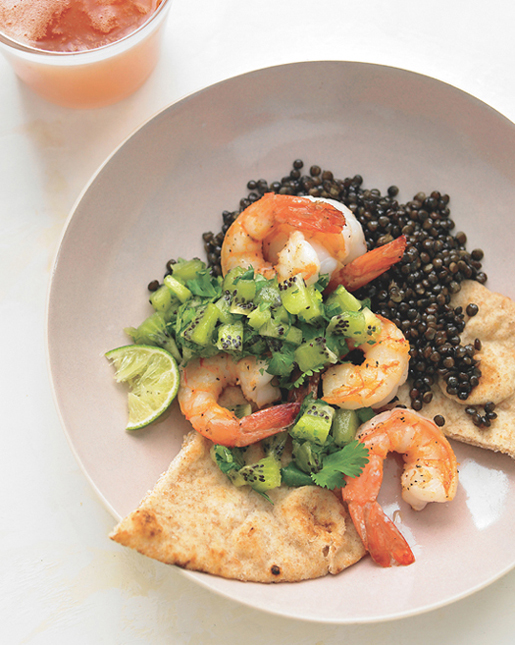
Shrimp with Kiwifruit-Lime Relish

SERVES 4
Kiwifruit, lime juice, chiles, and cilantro make a tropical—and antioxidant-rich—accompaniment to simple seared shrimp; you can also use the relish to top grilled fish, or as a healthy dip with tortilla chips. Serve the shrimp and relish with black lentils and whole-wheat naan (Indian flatbread), as shown, or with brown rice and tortillas.
2 jalapeño chiles, finely chopped (ribs and seeds removed for less heat, if desired)
2 tablespoons fresh lime juice (from 1 to 2 limes)
4 kiwifruits, peeled and diced
Coarse salt
½ cup finely chopped cilantro
20 large shrimp, preferably U.S. farmed, peeled and deveined (about 1 pound)
2 tablespoons neutral-tasting oil, such as canola or safflower
1 Stir jalapeños and lime juice together. Add kiwifruit, ¼ teaspoon salt (or to taste), and cilantro. Stir to combine.
2 Season shrimp with ½ teaspoon salt. Heat oil in a large skillet over high until shimmering. Add shrimp in a single layer and cook until pink on one side, about 3 minutes. Flip shrimp and cook until opaque throughout, about 2 minutes more. Serve with kiwifruit-lime relish.
per serving: 104 calories; .3 g saturated fat; 2.7 g unsaturated fat; 53.2 mg cholesterol; 11.3 g carbohydrates; 8.2 g protein; 462 mg sodium; 2.1 g fiber
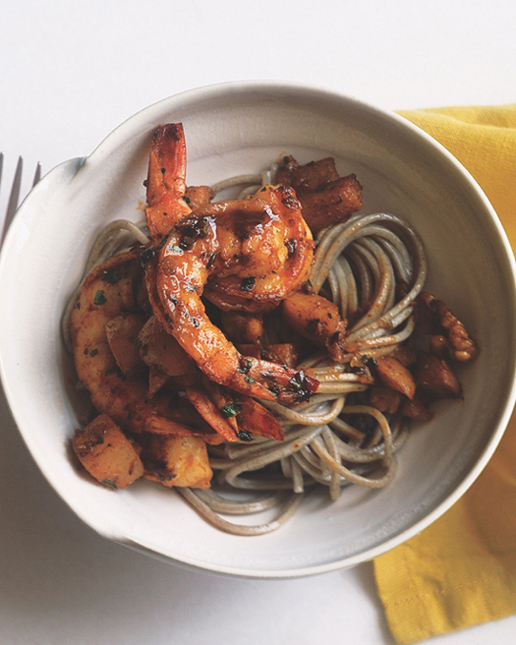

SERVES 4
A cross-continental blend of flavors, this dish features a lively sauce that combines European paprika and sake or mirin (rice wine) from Japan. Turnips, popular in both European and Asian cuisines, add fiber, potassium, calcium, and vitamin C. Serve the shrimp over whole-wheat pasta or brown rice.
2 to 3 tablespoons neutral-tasting oil, such as canola or safflower
1 tablespoon minced peeled fresh ginger
1½ teaspoons paprika
3 tablespoons chopped walnuts
20 large shrimp, preferably U.S. farmed, peeled and deveined (about 1 pound)
1½ cups cubed (¼-inch) peeled turnips
1 tablespoon apple-cider vinegar or sherry vinegar
3 tablespoons sake or mirin (rice wine)
Coarse salt and freshly ground pepper
¼ cup chopped fresh flat-leaf parsley (optional)
1 Heat oil in a large skillet over medium-high. Add ginger and paprika; cook, stirring, until fragrant, 20 to 30 seconds. Add walnuts; sauté, stirring, until lightly browned, 2 to 3 minutes.
2 Add shrimp; cook, stirring, until pink and opaque throughout, about 2 minutes per side. Stir in turnips, vinegar, sake, and 1 teaspoon salt; season with pepper. Continue to cook, stirring, until heated through, about 2 minutes. Stir in parsley, and serve warm.
per serving: 253 calories; 1.7 g saturated fat; 10.3 g unsaturated fat; 172 mg cholesterol; 6.4 g carbohydrates; 24.6 g protein; 204 mg sodium; 2.1 g fiber
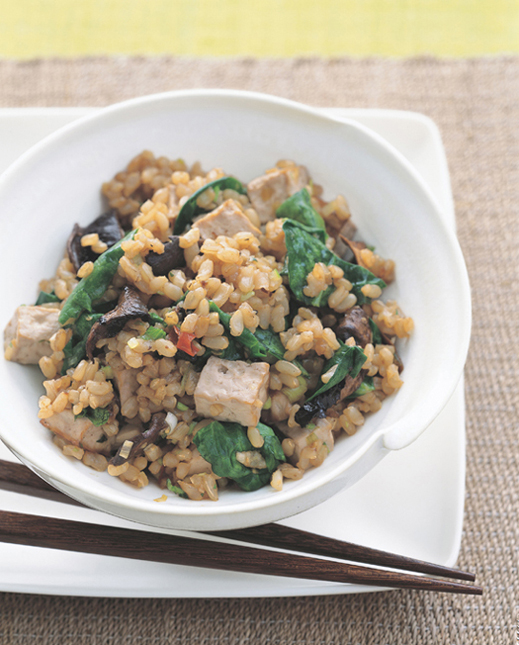
Brown Rice with Tofu, Dried Mushrooms, and Baby Spinach

SERVES 6
Brown rice is the foundation of a simple, protein-filled vegetarian dish when it’s paired with tofu. Spinach is “steamed” in the same pan for the ultimate in ease—and nutritional value.
1½ cups short-grain brown rice
2¾ cups water
½ ounce dried shiitake mushrooms (broken if large)
1 tablespoon finely chopped peeled fresh ginger
4 garlic cloves, minced
1 dried red chile, crumbled
Coarse salt
7 ounces (½ package) extra-firm tofu, drained and cut into ¾-inch cubes
3 ounces baby spinach
6 scallions, white and pale green parts only, finely chopped
¼ cup loosely packed cilantro leaves, finely chopped
2 tablespoons plus 1 teaspoon low-sodium tamari soy sauce
1½ tablespoons rice vinegar (unseasoned)
1 teaspoon toasted sesame oil
1 In a large saucepan, stir together rice, water, mushrooms, ginger, garlic, chile, and salt. Bring mixture to a boil; reduce to a simmer. Cover and cook until rice is tender and has absorbed all liquid; 45 to 50 minutes. Remove from heat.
2 Gently stir in tofu, and let stand, covered, 15 minutes. Stir in spinach. Cover, and let steam 3 minutes. Stir in scallions, cilantro, soy sauce, vinegar, and sesame oil. Serve immediately.
per serving: 247 calories; .3 g saturated fat; 2.7 g unsaturated fat; 0 mg cholesterol; 44.5 g carbohydrates; 9 g protein; 283 mg sodium; 3.8 g fiber

Vegetable-Rice Bowl with Miso Dressing

SERVES 4
Think of this recipe as a basic formula for making rice bowls, and then vary the beans (use canned ones to save time), squash, and greens, as desired.
FOR THE RICE BOWL
1 cup dried red azuki beans
Coarse salt
2 cups short-grain brown rice
3¼ cups water
½ butternut squash, peeled, seeded, and cut into ½-inch-thick pieces (4 cups)
14 ounces (1 package) firm tofu, halved and cut into ½-inch-thick triangles
¼ pound mixed greens, such as kale, chard, and beet greens (8 cups), stemmed, leaves chopped
FOR THE DRESSING
1 piece (1 inch) fresh ginger, peeled and coarsely chopped
2 tablespoons plus 2 teaspoons white miso
¼ cup low-sodium tamari soy sauce
¼ cup water
1 tablespoon plus 1 teaspoon toasted sesame oil
FOR THE CONDIMENTS
2 tablespoons dried arame or wakame (seaweed)
1 daikon radish, peeled and finely grated (about ½ cup)
2 teaspoons ume plum vinegar or seasoned rice vinegar
8 umeboshi plums, halved and pitted (optional)
Gomashio (sesame seeds dotted with salt) or toasted sesame seeds
1 Prepare the rice bowl: Place beans in a bowl; add enough water to cover by about 2 inches. Let soak overnight in the refrigerator. Drain beans, and rinse under cold running water; drain again. Transfer to a medium saucepan. Cover with water by about 2 inches, and bring to a boil. Reduce heat; simmer, stirring occasionally, until tender, about 30 minutes, seasoning with 1 teaspoon salt halfway through and adding more water, if necessary, to keep beans covered. Drain.
2 Meanwhile, place rice in another saucepan; add the 3¼ cups cold water and a large pinch of salt. Bring to a boil, stir once, and reduce heat. Simmer, covered, until rice is tender and has absorbed all liquid, 45 to 50 minutes. Remove from heat, and let stand (covered) 10 minutes.
3 Place the bottom basket of a large 2-tiered bamboo steamer in a wok or large pan filled with about 1 inch of simmering water (the water should just reach to bottom of basket; alternatively, use two pans fitted with steamer inserts). Carefully place squash slices in a single layer in bottom basket. Cover, and steam 10 minutes. Place tofu in a single layer in top basket, and top with greens. Cover, and carefully set atop bottom basket; steam until greens and squash slices are tender, 7 to 8 minutes more.
4 Meanwhile, make the miso dressing: Process ginger, miso, tamari, and the ¼ cup water in a food processor until smooth. With machine running, gradually add oil, and process until combined. Transfer to a small bowl.
5 Prepare the condiments: In a small bowl, cover seaweed with cool water. Let stand until soft, 10 to 15 minutes. Drain. Toss together daikon and vinegar in another bowl.
6 To serve, fluff rice with a fork and divide among four serving bowls; arrange beans, greens, tofu, squash, and seaweed on top, dividing evenly. Top each bowl with about 1 tablespoon daikon mixture and 2 plums. Drizzle with dressing, and sprinkle with gomashio.
per serving: 808 calories; 2 g saturated fat; 5 g unsaturated fat; 0 mg cholesterol; 142 g carbohydrates; 34 g protein; 1491 mg sodium; 18 g fiber

Whole-Wheat Pizza with Artichokes and Pecorino

SERVES 4
When you start with store-bought dough, homemade pizza comes together in minutes. Look for whole-wheat dough in the refrigerator section of health-food stores and some supermarkets. Frozen artichoke hearts are a convenient alternative to steaming fresh artichokes, and they retain much of their nutrients; if you use canned, rinse them well and let them drain. (Jarred, marinated artichokes are not recommended for this recipe.)
4 frozen artichoke hearts, thawed
1 tablespoon fresh lemon juice
1 tablespoon extra-virgin olive oil, plus more for baking sheet
1 pound whole-wheat pizza dough, room temperature
1 cup ricotta cheese, preferably fresh packed
2 plum tomatoes, thinly sliced crosswise
¼ cup pitted Kalamata olives, halved
3 ounces pecorino Romano cheese, shaved with a vegetable peeler
Coarse salt and freshly ground pepper
¼ cup packed fresh basil leaves
1 Thinly slice the artichoke hearts crosswise, then place in a small bowl. Add lemon juice, and toss to coat.
2 Preheat oven to 450°F. Lightly oil a baking sheet. Stretch dough to a 12-by-16-inch oval. Place dough on prepared sheet and brush with 1 tablespoon oil, making sure to coat edges well. Scatter spoonfuls of ricotta over dough. Top evenly with tomatoes, artichokes, olives, and three-quarters of the pecorino. Season with ¾ teaspoon salt (or to taste) and pepper.
3 Bake pizza until crust is browned and toppings are heated through, 20 to 25 minutes. Remove from oven. Sprinkle with basil and remaining pecorino, and serve immediately.
per serving: 579 calories; 9.7 g saturated fat; 9.8 g unsaturated fat; 46.9 mg cholesterol; 71 g carbohydrates; 28.4 g protein; 1307 mg sodium; 10.8 g fiber


SERVES 6
A relative of spinach and beets, Swiss chard offers fantastic antioxidant protection in the form of carotenoids, which help maintain eye health, boost immunity, and may even fight cancer. Here, chard leaves are rolled around a protein-rich quinoa-mushroom filling for an elegant entrée.
2 bunches Swiss chard (about 2 pounds), preferably red
1 cup quinoa
5 cups homemade or reduced-sodium store-bought chicken or vegetable broth
1 tablespoon unsalted butter
2 tablespoons extra-virgin olive oil, plus more for brushing
2 shallots, finely chopped
2 large carrots, peeled and cut into ⅛-inch dice
1 pound cremini mushrooms, stems removed, caps cleaned
1 pound fresh shiitake mushrooms, stems removed, caps cleaned
Coarse salt and freshly ground pepper
2 tablespoons fresh marjoram leaves (or 1 teaspoon dried)
2 tablespoons Marsala (Italian fortified wine) or port wine
1 Preheat oven to 350°F. Prepare an ice-water bath. Bring a large pot of water to a boil. Blanch chard until tender and bright green, about 2 minutes. Using a slotted spoon or tongs, transfer chard to the ice bath; let cool, then transfer to paper towels and pat dry. Reserve leaves, being careful not to tear them. Cut off stem, making a V shape about 1 inch up from bottom of leaf. Chop stems into ¼-inch pieces.
2 Meanwhile, place quinoa and 2¼ cups broth in a medium saucepan. Bring to a boil, and stir once. Reduce heat; simmer (uncovered) until quinoa is tender and has absorbed all liquid, about 15 minutes. Transfer quinoa to a large bowl; keep in a warm place.
3 Heat a large sauté pan over medium-high; add butter and oil. When hot, add shallots and carrots; cook, stirring, until shallots are translucent, about 1 minute. Add mushroom caps, chard stems, and ½ teaspoon salt; season with pepper. Sauté until vegetables are tender, stirring occasionally, about 8 minutes.
4 Remove 1½ cups mushroom mixture from pan; add to quinoa. Reserve remaining mushroom mixture. Coarsely chop 1 tablespoon marjoram (or add ½ teaspoon dried); stir into quinoa.
5 Divide chard leaves into six portions. Form one portion into a 6-by-10-inch rectangle, overlapping leaves so there are no gaps. Place ½ cup quinoa mixture at a short end, then roll up chard, enclosing sides. Brush lightly with oil; place in an 8-inch baking dish. Repeat, making 5 more rolls. Bake until heated through, 5 to 10 minutes.
6 Heat remaining mushroom mixture over medium-high. Add Marsala; cook, stirring, until most of the liquid has been absorbed. Add remaining 2¾ cups broth; cook, stirring occasionally, until slightly thickened, about 6 minutes. Stir in remaining 1 tablespoon marjoram (or ½ teaspoon dried).
7 To serve, slice each chard roll in half; place in the center of a plate. Spoon the mushroom mixture around chard.
per serving: 258 calories; 2.4 g saturated fat; 6.4 g unsaturated fat; 5 mg cholesterol; 32.2 g carbohydrates; 12.6 g protein; 93 mg sodium; 6 g fiber
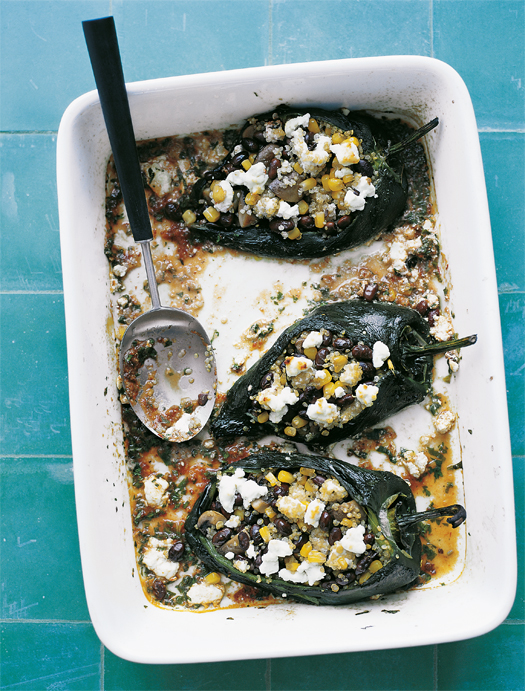
Stuffed Poblanos in Chipotle Sauce

SERVES 4
Stuffed with quinoa, black beans, mushrooms, and corn, these peppers make a satisfying vegetarian main course. Poblanos are among the mildest chiles, although they still offer a nice zing. Chipotle chiles are smoked, roasted jalapeños, usually sold in cans with a spicy adobo sauce.
4 large poblano chiles
2 teaspoons plus 1 tablespoon neutral-tasting oil, such as canola or safflower
1 tablespoon chopped chipotle chile in adobo
1 garlic clove
Coarse salt and freshly ground pepper
½ cup packed cilantro leaves, coarsely chopped, plus more for garnish
⅓ cup quinoa
8 ounces small mushrooms, such as white button or cremini, trimmed, cleaned, and quartered
1 cup fresh or frozen corn kernels
1 can (15 ounces) black beans, drained and rinsed
4 ounces crumbled fresh goat cheese (1 cup)
1 Preheat oven to 475°F. On a parchment-lined baking sheet, rub poblanos with 2 teaspoons oil. Roast until slightly blackened and softened, 15 to 20 minutes, turning once. Remove from oven. When cool enough to handle, remove skins with paper towels. Use a paring knife to make a small slit in each chile, then carefully remove seeds (and discard), keeping stem end intact.
2 In a blender, combine chipotle, garlic, 1 teaspoon salt, and ¾ cup water; season with pepper. Blend until smooth. Add cilantro, and pulse once to combine.
3 In a small saucepan, bring ⅔ cup water to a boil. Add quinoa; return to a boil. Stir once, cover, and reduce heat to a simmer. Cook until quinoa is tender but still chewy and has absorbed all liquid, about 15 minutes. Fluff with a fork.
4 Meanwhile, in a large skillet, heat the remaining 1 tablespoon oil over medium-high. Add mushrooms and ½ teaspoon salt; season with pepper. Cook, stirring occasionally, until mushrooms are tender, about 5 minutes. Add corn and beans, and cook, stirring, until heated through, about 2 minutes. Stir in ½ cup cheese and the quinoa.
5 Spread chipotle mixture evenly in a 9-by-13-inch baking dish. Stuff peppers with filling, dividing evenly, and arrange in dish; dot with remaining ½ cup cheese. Bake until golden, 15 to 20 minutes. Remove from oven, and let cool in pan 10 minutes before serving.
per serving: 324 calories; 3.2 g saturated fat; 4.7 g unsaturated fat; 12.6 mg cholesterol; 49.5 g carbohydrates; 14.4 g protein; 910 mg sodium; 9.4 g fiber

Whole-Wheat Spaghetti with Herb-Almond Pesto and Broccoli

SERVES 6
A snappy almond-and-herb pesto is a fresh departure from the classic pine-nut-and-basil version. For an even more nutritious variation, add three tablespoons ground flaxseed to the pesto.
12 ounces whole-wheat spaghetti
1¼ ounces whole blanched almonds, toasted
2 tablespoons finely grated lemon zest, plus ¼ cup fresh lemon juice (from about 3 lemons)
1 garlic clove
1 cup packed fresh flat-leaf parsley
½ cup packed fresh mint leaves
¼ cup packed fresh tarragon leaves
Coarse salt and freshly ground pepper
3 tablespoons extra-virgin olive oil
2 heads (2¼ pounds) broccoli, cut into small florets (about 6 cups)
3 tablespoons part-skim ricotta cheese
Lemon wedges, for serving
1 Bring a large pot of water to a boil. Cook pasta until al dente according to package instructions. Reserve ½ cup cooking liquid; drain pasta.
2 Pulse almonds in a food processor until finely ground. Add 1 tablespoon lemon zest along with the lemon juice, garlic, herbs, and ½ teaspoon salt; process until finely chopped. With machine running, gradually add 2 tablespoons oil and the reserved cooking water; process until pesto is smooth. The pesto will keep for 1 week in the refrigerator or up to 1 month in the freezer; store in an airtight container, covered with a thin layer of olive oil. To serve, bring the pesto to room temperature (never heat it), pour off extra oil from top, and stir in a little water, if necessary, to achieve the proper consistency.
3 Heat a large sauté pan over medium-high. Add remaining 1 tablespoon oil. When hot, add broccoli and 1½ teaspoons salt; season with pepper. Cook, tossing occasionally, until broccoli is lightly browned and crisp, 5 to 7 minutes. Add pasta and pesto; toss to coat.
4 Divide pasta among six bowls. Dollop with ricotta, and sprinkle with remaining 1 tablespoon zest, dividing evenly. Squeeze lemon wedges over tops, and serve immediately.
per serving: 345 calories; 1 g saturated fat; 7 g unsaturated fat; 3 mg cholesterol; 56 g carbohydrates; 16 g protein; 448 mg sodium; 14 g fiber
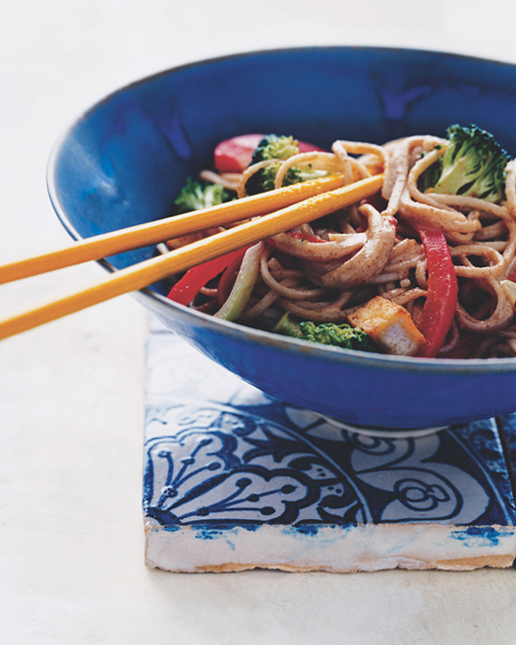
Soba Noodle, Tofu, and Vegetable Stir-Fry

SERVES 4
Here’s a spicy noodle dish that’s packed with vegetables; covering the pan during cooking helps trap the steam so the vegetables soften more quickly (and retain their nutrients). Look for soba noodles made entirely of buckwheat flour; besides being gluten-free, they are more nutritious than soba made from whole-wheat flour.
8 ounces soba noodles (preferably 100 percent buckwheat)
2 tablespoons grapeseed oil
14 ounces (1 package) extra-firm tofu, drained, patted dry, and cut into ½-inch cubes
Coarse salt
2 red bell peppers, ribs and seeds removed, thinly sliced lengthwise
1 head (1½ pounds) broccoli, broken into small florets
1 head (1 pound) bok choy, trimmed and thinly sliced crosswise
4 garlic cloves, minced
½ teaspoon crushed red pepper flakes
3 tablespoons almond butter
2 tablespoons water
3 tablespoons rice vinegar (unseasoned)
2 tablespoons low-sodium tamari soy sauce
1 Bring a large pot of water to a boil. Cook soba noodles until tender according to package instructions. Drain, and rinse with cold water; drain again.
2 Heat 1 tablespoon oil in a large skillet over medium-high; add tofu and 1 teaspoon salt. Cook, tossing occasionally, until golden, 12 to 15 minutes. Transfer to a plate.
3 Heat remaining 1 tablespoon oil in same skillet over medium-high. Add bell peppers, broccoli, bok choy, garlic, red pepper flakes, and 1 teaspoon salt. Cover (pan will be very full), and cook, tossing occasionally, until vegetables are crisp-tender, 8 to 10 minutes.
4 Meanwhile, make sauce: In a small bowl, whisk together almond butter and the water, then whisk in vinegar and soy sauce.
5 Add reserved noodles, tofu, and sauce to pan with vegetables. Cook, tossing, until noodles are heated through, 2 to 3 minutes. Serve immediately.
per serving: 511 calories; 1.53 g saturated fat; 12.5 g unsaturated fat; 0 mg cholesterol; 67 g carbohydrates; 26.7 g protein; 670 mg sodium; 7.6 g fiber

Whole-Wheat Pasta with Lentils, Spinach, and Leeks

SERVES 6
French green lentils, sometimes called lentilles du Puy, hold their shape well once cooked, making them particularly suited to salads and pasta dishes. Like other legumes, lentils are low in fat and are exceptional sources of folate, iron, and protein, plus other vitamins and minerals. Here, the lentils are combined with whole-wheat pasta shapes called chiocciole (snails), but you can substitute penne or any other short tubular shapes. If you like, grate or shave parmesan over the pasta just before serving.
2 cups (14 ounces) French green lentils
2 garlic cloves
1 dried bay leaf
1 pound tubular whole-wheat pasta, such as penne
2 tablespoons extra-virgin olive oil, plus more for drizzling
4 leeks (about 1¾ pounds), white and pale green parts only, sliced into ¼-inch rounds, washed well, and drained
1 teaspoon chopped fresh thyme
Coarse salt and freshly ground pepper
8 ounces baby spinach
1 In a saucepan, combine lentils, 1 garlic clove, and the bay leaf. Add enough cold water to cover by 2 inches. Bring to a boil over medium-high heat. Reduce heat to medium-low, and simmer until lentils are tender, 20 to 25 minutes. Drain lentils, and discard garlic clove and bay leaf.
2 Bring a large pot of water to a boil. Cook pasta until al dente according to package instructions. Reserve 1 cup cooking liquid; drain pasta, and place in a large bowl.
3 Meanwhile, mince remaining garlic clove. In a large sauté pan, heat oil over medium. Add minced garlic, leeks, and thyme; cook, stirring occasionally, until leeks are soft but not browned, about 5 minutes. Add cooked lentils and 1½ teaspoons salt; season with pepper.
4 Add spinach and reserved pasta cooking liquid to pan; cook, tossing to wilt spinach, about 2 minutes. Pour mixture over pasta, and toss to combine. Serve immediately, drizzled with olive oil, if desired.
per serving: 579 calories; .7 g saturated fat; 4.1 g unsaturated fat; 0 mg cholesterol; 106 g carbohydrates; 24.6 g protein; 372 mg sodium; 19 g fiber

Spinach Pasta with Corn, Edamame, and Green Beans

SERVES 4
Edamame contain as much protein per serving as eggs, milk, and meat, and are also a good source of iron, zinc, and B vitamins. Since the corn is not cooked, it’s imperative that you use the freshest you can find. Serve hot or cold as a speedy, summery pasta dish.
1 pound short spinach pasta, such as shells or penne
2 cups (about 6 ounces) fresh green beans, trimmed
2 cups (about 8 ounces) frozen shelled edamame
2 ears of corn, shucked, kernels cut from cobs
2 garlic cloves, minced
3 tablespoons extra-virgin olive oil
Finely grated zest and juice of 1 lemon
1 cup loosely packed fresh basil leaves, torn
Coarse salt and freshly ground pepper
1 Bring a large pot of water to a boil. Cook pasta until al dente according to package instructions, adding the green beans and edamame 3 to 4 minutes before end of cooking. Drain pasta and vegetables, then place in a bowl.
2 Add corn kernels and immediately stir in garlic and oil. Add lemon zest and juice, basil, and ½ teaspoon salt; season with pepper, and stir to combine.
per serving: 824 calories; 2.9 g saturated fat; 12.8 g unsaturated fat; 108 mg cholesterol; 129 g carbohydrates; 35.6 g protein; 263 mg sodium; 20.2 g fiber
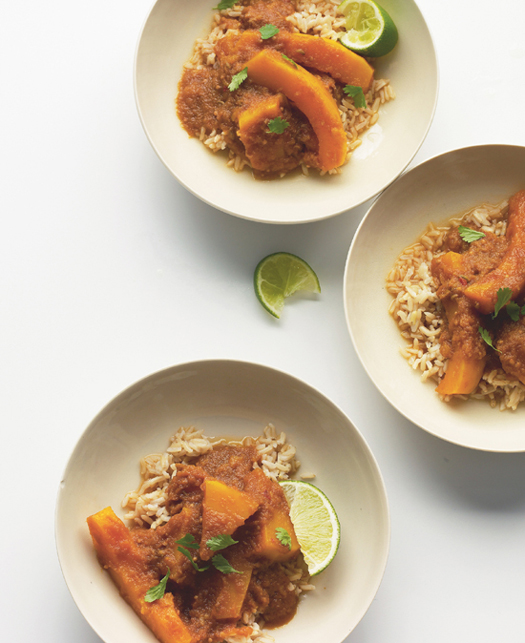

SERVES 4
Rather than relying on store-bought curry paste, this dish uses a quick homemade version that’s incomparably fresh and vibrantly flavored. For a thicker curry, mash some of the squash with the back of a wooden spoon.
1 cup long-grain brown rice
5 cups plus 1 tablespoon water
2 small butternut squash (2 pounds), peeled, halved lengthwise, and seeded
1 large onion, cut into large chunks
4 garlic cloves
1 tablespoon neutral-tasting oil, such as canola or safflower
1 teaspoon mustard seeds
1 teaspoon fennel seeds
¼ teaspoon ground coriander
1 piece (2 inches) fresh ginger, peeled and finely grated
2 tablespoons tomato paste
Coarse salt
¼ teaspoon crushed red pepper flakes
Cilantro, for garnish
Lime wedges, for garnish
1 Place rice in a medium saucepan. Add 2 cups water and bring to a boil; stir once, and reduce heat. Simmer, covered, until rice is tender and has absorbed all liquid, 35 to 40 minutes. Remove from heat; let stand 10 minutes (covered).
2 Meanwhile, cut solid sections of squash into large chunks and seeded sections into ¾-inch thick wedges. Puree onion, garlic, and 1 tablespoon water in a blender until smooth.
3 Heat the oil in a 4-quart pot over medium. Add the mustard and fennel seeds and the coriander; cook, stirring, until fragrant, 1 to 2 minutes. Stir in the onion paste and ginger. Cook, stirring often, until caramelized, 6 to 8 minutes.
4 Add tomato paste, and cook 1 minute, stirring and scraping bottom of pot, if needed. Stir in remaining 3 cups water, 2 teaspoons salt, and red pepper flakes. Add squash, and cover partially. Bring to a boil. Reduce heat, and simmer gently until squash is tender, 12 to 15 minutes.
5 Fluff rice with a fork, then divide among four bowls. Spoon curry mixture on top, and garnish with cilantro and lime wedges. Serve immediately.
per serving: 337 calories; .6 g saturated fat; 4.5 g unsaturated fat; 0 mg cholesterol; 70 g carbohydrates; 7.2 g protein; 1052 mg sodium; 7.6 g fiber
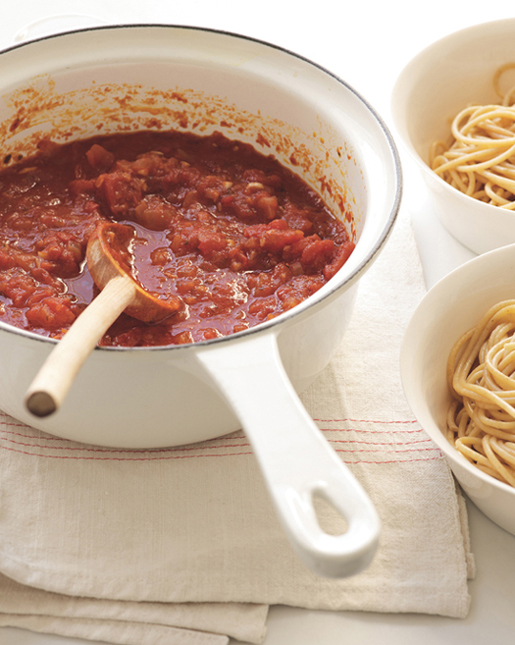

MAKES ABOUT 4 CUPS
This sauce tastes great over pasta, fish, or grilled chicken—and is packed with beneficial lycopene from the cooked tomatoes.
¼ cup extra-virgin olive oil
1 red onion, minced
8 garlic cloves, minced
2 cans (14 ounces each) diced tomatoes in juice
¼ cup plus 2 tablespoons dry red wine
1 teaspoon dried oregano, crumbled
1 teaspoon dried basil, crumbled
Coarse salt
1 In a medium saucepan, heat oil over medium. Add onion and garlic; cook, stirring frequently, until softened, about 7 minutes.
2 Stir in the tomatoes and their juice, wine, oregano, basil, and ¼ teaspoon salt. Simmer until lightly thickened, 8 to 10 minutes. Season with ½ teaspoon salt, or to taste. Serve immediately, or let cool completely before storing. The sauce can be refrigerated up to 5 days, or frozen up to 1 month, in an airtight container; thaw in the refrigerator and reheat in a pan over medium.
per 1/2-cup serving: 79 calories; 1 g saturated fat; 6 g unsaturated fat; 0 mg cholesterol; 3.1 g carbohydrates; .5 g protein; 107 mg sodium; .5 g fiber


SERVES 4
High in iron, vitamins, and fiber, barley risotto is a nutritious (and quicker-cooking) alternative to a traditional risotto made with rice. This vegetarian dish also includes frozen peas, which are always available, easy to use, and contain nearly as many nutrients as fresh-picked. As a good source of chromium, peas also help control blood sugar levels.
2 tablespoons olive oil
1 cup pearl barley
2 leeks, white and pale green parts only, thinly sliced, washed well and drained
½ cup dry white wine (or water)
2 cups water
Coarse salt and freshly ground pepper
2 cups homemade or low-sodium store-bought vegetable broth
1 bunch asparagus (about 1 pound), tough ends trimmed, cut on the diagonal into 2-inch lengths
1 package (10 ounces) frozen peas, thawed
½ cup grated parmesan cheese
¼ cup packed thinly sliced fresh mint leaves, plus whole small leaves for garnish
1 In a large saucepan, heat oil over medium. Add barley and leeks; cook, stirring occasionally, until they begin to soften, 5 to 7 minutes. Add wine; cook, stirring, until evaporated, about 5 minutes. Add the water and bring to a boil; add ½ teaspoon salt and season with pepper to taste. Reduce heat; simmer, stirring occasionally, until liquid has been absorbed, about 10 minutes.
2 Add broth and continue to cook, stirring occasionally, until barley is tender and liquid is creamy, about 10 minutes. Add asparagus; cook until tender, about 5 minutes. Stir in peas and cook just until heated through. Remove from heat. Stir in parmesan and mint; season with pepper. Garnish with mint leaves, and serve.
per serving: 426 calories; 2.9 g saturated fat; 7.6 g unsaturated fat; 8.8 mg cholesterol; 62.4 g carbohydrates; 15.7 g protein; 465 mg sodium; 15.5 g fiber

Swiss Chard, Mushroom, and Quinoa Salad

SERVES 4
This main-course salad combines chard, mushrooms, and quinoa to form a satisfying vegetarian meal abundant with vitamins, minerals, and complete protein.
2 cups water
1 cup quinoa, rinsed and drained
1 tablespoon extra-virgin olive oil
1 pound Swiss chard, stems and leaves cut into ½-inch pieces (about 10½ cups), rinsed well, water still clinging to leaves
Coarse salt and freshly ground pepper
Pinch of crushed red pepper flakes
1 garlic clove, minced
12 ounces cremini mushrooms, trimmed, cleaned, and thinly sliced
2 teaspoons finely chopped fresh thyme
1 ounce shaved parmesan cheese (½ cup)
1 In a medium saucepan, bring the water to a boil. Add quinoa and reduce heat to a simmer. Cover and cook until quinoa is tender and has absorbed all liquid, about 15 minutes. Remove from heat. Meanwhile, heat 1 teaspoon oil in a large skillet over medium. Cook chard (stems and leaves), stirring occasionally, until wilted and tender, about 8 minutes. Add ¼ teaspoon salt; season with pepper. Add red pepper flakes, and toss to combine. Transfer to a platter.
2 Add remaining 2 teaspoons oil and the garlic to skillet. Cook over medium heat, stirring, until garlic is lightly golden, about 1 minute. Add mushrooms, and cook, stirring occasionally, until they start to release their juices, about 3 minutes. Add ½ teaspoon salt; season with pepper. Cook, stirring occasionally, until mushrooms are tender, about 5 minutes. Stir in quinoa; cook to heat through, about 1 minute. Stir in thyme; remove from heat.
3 To serve, divide chard among plates, and spoon quinoa mixture on top. Sprinkle parmesan over each portion.
per serving: 252 calories; 1 g saturated fat; 6 g unsaturated fat; 3 mg cholesterol; 38 g carbohydrates; 1 g protein; 666 mg sodium; 5 g fiber
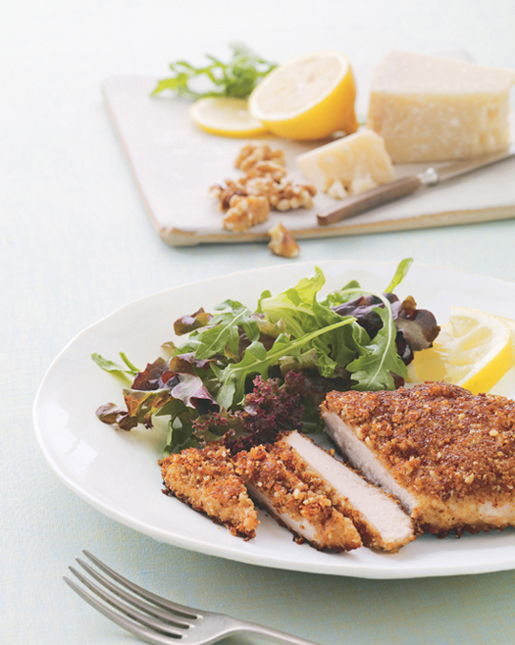
Walnut-Crusted Chicken Breasts

SERVES 4
Walnuts add a healthful dose of omega-3 fatty acids to bread crumbs, which keep the chicken moist. Roasting the chicken, rather than frying it, yields a crisp crust without adding much extra fat. If you don’t have day-old bread, lightly toast fresh bread to use instead.
2 slices day-old whole-wheat bread
⅓ cup walnuts
2 tablespoons finely grated parmesan cheese
Coarse salt and freshly ground pepper
1 large egg white
4 boneless, skinless chicken breast halves (6 to 8 ounces each)
1 tablespoon grapeseed oil
Lemon slices, for serving
1 Preheat oven to 425°F. In a food processor, combine bread, walnuts, parmesan, and ¼ teaspoon salt; season with pepper. Process until fine crumbs form. Transfer to a shallow bowl. In another bowl, beat egg white until frothy.
2 Pat dry chicken with paper towels. Season chicken on both sides with ½ teaspoon salt, dividing evenly, and pepper. Dip each chicken breast into egg white to coat completely, then let excess drip off before dredging in crumb mixture, pressing to adhere.
3 Heat the oil in a large ovenproof skillet over medium until hot but not smoking. Cook chicken until lightly browned on one side, 1 to 3 minutes. Flip chicken and transfer skillet to oven. Bake until golden brown and cooked through, 8 to 12 minutes. Serve with lemon slices.
per serving: 331 calories; 1.9 g saturated fat; 9.6 g unsaturated fat; 101 mg cholesterol; 8.5 g carbohydrates; 44 g protein; 603 mg sodium; 1.6 g fiber

Chicken Breasts with Fennel, Carrots, and Couscous

SERVES 4
After the chicken is browned and the vegetables are sautéed, the meat is braised until fork-tender. Orange juice adds vitamin C and brightens the dish, but you can omit it and increase the chicken stock by half a cup.
1 cup water
⅔ cup couscous
4 boneless, skinless chicken breast halves (6 to 8 ounces each)
1¾ teaspoons paprika
Coarse salt and freshly ground pepper
2 tablespoons neutral-tasting oil, such as canola or safflower
1 fennel bulb, trimmed, cored, and thinly sliced
3 large carrots, peeled and thinly sliced
1 teaspoon ground cumin
⅔ cup dried apricots, preferably unsulfured, chopped
½ cup oil-cured pitted black olives, halved
½ cup fresh orange juice
½ cup homemade or reduced-sodium store-bought chicken broth
1 Bring the water to a boil in a small saucepan; add couscous, and stir to combine. Cover and let stand until tender, about 5 minutes, then fluff with a fork.
2 Pat chicken dry with paper towels. Rub chicken on both sides with ¾ teaspoon paprika and ½ teaspoon salt, dividing evenly; season with pepper. In a large skillet, heat 1 tablespoon oil over medium-high. Cook chicken until lightly browned, about 3 minutes per side; transfer to a plate.
3 Reduce heat to medium. Add remaining 1 tablespoon oil; when hot, add fennel and carrots. Cook, stirring occasionally, until vegetables are crisp-tender and lightly browned, 5 to 7 minutes. Add remaining 1 teaspoon paprika, the cumin, and ¼ teaspoon salt; season with pepper. Cook, stirring, until spices are fragrant, about 1 minute.
4 Add chicken and any accumulated juices from plate to skillet along with the apricots, olives, orange juice, and broth. Cover and simmer until vegetables are soft and chicken is cooked through, 12 to 15 minutes. Serve with couscous.
per serving: 492 calories; 1.4 g saturated fat; 8.9 g unsaturated fat; 99 mg cholesterol; 50 g carbohydrates; 46.5 g protein; 703 mg sodium; 6.5 g fiber

Chicken with Pumpkin-Seed Mole

SERVES 6
This rich pumpkin-seed sauce, based on traditional Mexican moles, is made with green herbs, and is just as satisfying as cheese- or cream-based sauces but contains far less saturated fat and fewer calories. Serve the dish with rice for an authentic accompaniment.
3 boneless, skinless chicken breast halves (about 6 ounces each)
1 small serrano chile
1 small poblano chile
1 small white onion, cut into ¼-inch dice
2 garlic cloves
1 cup cilantro leaves, plus sprigs for garnish
½ teaspoon ground cumin
¾ teaspoon dried oregano, preferably Mexican
½ cup raw hulled pumpkin seeds (pepitas), toasted
2 cups homemade or reduced-sodium store-bought chicken broth
1 tablespoon neutral-tasting oil, such as canola or safflower
Coarse salt
2 tablespoons fresh lime juice (from 2 to 3 limes)
1 Place chicken in a 4-quart pot, and add water to cover by 1 inch. Bring to a gentle simmer over medium heat, and simmer until chicken is cooked through, about 15 minutes. Remove from heat, and let stand 15 minutes. Transfer chicken to a plate, and tent loosely with foil. Discard water.
2 Roast both chiles directly over the flame of a gas-stove burner on high heat, turning with tongs, until blackened all over. (Alternately, place chiles under the broiler, turning often, until skin has charred.) Transfer the chiles to a bowl, and cover with plastic wrap. Let steam 15 minutes. Using paper towels, rub off skins, then remove stems, seeds, and ribs.
3 In a blender, puree roasted chiles, onion, garlic, cilantro leaves, cumin, oregano, toasted pumpkin seeds, and ½ cup broth to form a coarse paste.
4 Heat oil in a medium skillet over medium. Add chile paste, and cook, stirring constantly, until very thick, about 8 minutes. (Reduce heat if mixture begins to scorch.) Whisk remaining 1½ cups broth into paste until incorporated. Add ½ teaspoon salt and the lime juice.
5 Add chicken to sauce in skillet. Cook over medium-low heat, turning occasionally, until just heated through, about 5 minutes (do not let simmer, or sauce will “break,” or separate).
6 With tongs, transfer chicken to a cutting board, let excess sauce drip back into pot, and slice in half crosswise. Divide chicken evenly among four plates, spoon sauce on top, and garnish with cilantro sprigs.
per serving: 294 calories; 2.6 g saturated fat; 10.5 g unsaturated fat; 67 mg cholesterol; 7.2 g carbohydrates; 36 g protein; 222 mg sodium; 2 g fiber
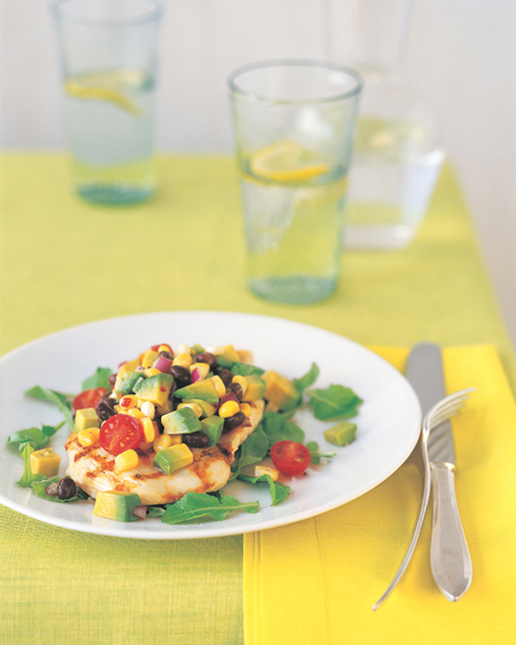
Lemon Chicken with Avocado-Corn Salsa

SERVES 4
Avocados in the salsa supply a generous portion of monounsaturated fat and fiber. If fresh corn is not in season, opt for frozen; it will taste better and have more nutrients than any “fresh” corn in the grocery store.
4 boneless, skinless chicken breast halves (6 to 8 ounces each)
¼ cup plus 2 teaspoons extra-virgin olive oil
2 tablespoons plus 2 teaspoons fresh lemon juice (from 1 to 2 lemons)
2 ears corn, husks and silks removed (or 1 cup frozen corn kernels)
2 teaspoons finely chopped red jalapeño chiles (ribs and seeds removed for less heat, if desired)
2 tablespoons minced peeled fresh ginger
½ cup canned black beans, drained and rinsed
½ red onion, finely chopped
¼ cup fresh lime juice (from 3 to 4 limes)
10 cherry tomatoes, quartered
2 firm, ripe Hass avocados, halved lengthwise, pitted, peeled, and diced
Coarse salt and freshly ground pepper
4 ounces baby arugula
1 Combine chicken with 2 tablespoons each oil and lemon juice in a shallow baking dish. Cover and marinate in refrigerator for 1 to 3 hours, turning once.
2 Working in a large bowl, stand each ear of corn on its flat end; shave off kernels with a serrated knife (to yield about 1 cup total).
3 Heat 1 tablespoon oil in a medium skillet over medium. Add corn kernels, chiles, and ginger; cook, stirring frequently, until softened, 3 to 4 minutes. Let cool.
4 Heat a grill (or grill pan) to medium (if using a charcoal grill, coals are ready when you can hold your hand 5 inches above grates for just 6 to 8 seconds). Grill chicken until lightly browned and cooked through, about 5 minutes per side. Remove from heat.
5 Stir together black beans, onion, corn mixture, lime juice, and 1 tablespoon oil. Add tomatoes, avocados, and ½ teaspoon salt (or to taste); season with pepper, and stir gently to combine.
6 Toss arugula with remaining 2 teaspoons each oil and lemon juice. Divide evenly among plates, and top with chicken and avocado-corn salsa. Serve immediately.
per serving: 524 calories; 5 g saturated fat; 4 g unsaturated fat; 68 mg cholesterol; 29 g carbohydrates; 34 g protein; 244 mg sodium; 11 g fiber

Turkey Cutlets with Tomatoes and Capers

SERVES 4
Lower in saturated fat than chicken, turkey provides one of the leanest sources of animal protein. The nutrient-dense poultry also contains heart-healthy B vitamins and selenium. Round out this simple preparation with a side of steamed green beans.
4 turkey cutlets (about 4 ounces each)
Coarse salt and freshly ground pepper
2 tablespoons neutral-tasting oil, such as canola or safflower
1½ cups diced tomato (1 large)
12 caper berries or ¼ cup capers, rinsed and drained
1 Pat dry cutlets with paper towels and season both sides with ½ teaspoon salt, dividing evenly, and pepper. Heat 1 tablespoon oil in a large skillet over high until shimmering. Add 2 cutlets, and cook until golden brown on bottom, about 2 minutes. Flip and continue to cook until other side is golden brown, about 2 minutes more. Transfer cutlets to plates; reduce heat to medium, and repeat with remaining 1 tablespoon oil and 2 cutlets.
2 Add tomato to hot skillet. Cook, stirring, until juicy and just softened, about 2 minutes. Add caper berries, and stir to warm through; spoon mixture over turkey, dividing evenly, and serve.
per serving: 193 calories; .5 g saturated fat; 6 g unsaturated fat; 45 mg cholesterol; 2.7 g carbohydrates; 28.7 g protein; 601 mg sodium; .8 g fiber

Grilled Pork Tenderloin and Apricots with Honey Glaze

SERVES 4
A mortar and pestle make easy work of crushing whole spices and peppercorns, but you can also use the bottom of a skillet or even the flat side of a chef’s knife, pressing down firmly and working on a cutting board. Choose apricots that are ripe but still firm so they can hold up under the heat of the grill; brush the apricots and pork with the glaze as soon as they come off the heat. The glaze also tastes great on other grilled meats.
1 teaspoon coriander seeds
½ teaspoon whole black peppercorns
1 piece (2 inches) fresh ginger, peeled and thinly sliced
¾ cup honey
2 tablespoons apple-cider vinegar
Coarse salt and freshly ground pepper
2 pork tenderloins (about 1¼ pounds)
3 tablespoons neutral-tasting oil, such as canola or safflower
8 scallions
6 medium-ripe apricots (about 1 pound), halved and pitted
1 Coarsely crush coriander seeds and peppercorns. Toast in a small saucepan over medium heat until fragrant, shaking pan occasionally, 1 to 2 minutes. Add ginger, honey, vinegar, and ¼ teaspoon salt; cook, stirring occasionally, until bubbling rapidly, about 5 minutes. Remove from heat and let stand 15 minutes; strain into a small dish.
2 Heat a grill (or grill pan) to high (if using a charcoal grill, coals are ready when you can hold your hand 5 inches above grill for just 2 to 3 seconds). Sprinkle pork on all sides with ½ teaspoon salt, and season with ground pepper; brush with 1 tablespoon oil. Cook until browned, about 3 minutes per side. Move pork to indirect heat (or reduce heat to low if using a grill pan) and cook until an instant-read thermometer inserted in middle reaches 138°F, 10 to 12 minutes. Transfer to a cutting board; spoon 2 to 3 tablespoons of glaze over pork. Let rest 10 minutes before slicing.
3 Meanwhile, grill scallions until lightly charred and tender, about 3 minutes. Brush apricots with remaining 2 tablespoons oil. Cook, cut side down, until apricots are marked by the grill and release easily from the grates, about 3 minutes. Flip and cook until bubbling around the edges, skins pull away, and apricots are tender when pressed, about 2 minutes more. Dividing evenly, transfer to four serving plates, and drizzle glaze over each apricot half. Serve warm with pork and scallions.
per serving: 491 calories; 3.1 g saturated fat; 11.4 g unsaturated fat; 92 mg cholesterol; 61 g carbohydrates; 31.3 g protein; 537 mg sodium; 2.2 g fiber

Pork Tenderloin with Sautéed Beet Greens and Roasted Beets

SERVES 4
Roasting beets takes a bit longer than boiling them, but the time spent is well worth it for the resulting rich flavor. Using both the greens and the roots makes beets a great bargain.
2 bunches beets (3 to 4 pounds with greens), greens separated and chopped, washed, and drained with some water left clinging (about 9 cups greens)
2 pork tenderloins (about 1¼ pounds)
Coarse salt and freshly ground pepper
¼ cup extra-virgin olive oil
2 teaspoons Dijon mustard
2 teaspoons plus 1 tablespoon red-wine vinegar
2 garlic cloves, smashed
2 tablespoons pine nuts, toasted
1 Preheat oven to 400°F. Loosely wrap beets in a 12-by-20-inch piece of parchment, then wrap packet in foil. Place on a rimmed baking sheet and cook until easily pierced with the tip of a sharp knife, 35 to 45 minutes. When cool enough to handle, rub off skins with paper towels. Reserve 1 beet; halve and slice remaining beets.
2 Season pork all over with 2 teaspoons salt, dividing evenly, and pepper. Place on a rimmed baking sheet and roast until an instant-read thermometer inserted in middle reaches 138°F, 14 to 16 minutes. Transfer to a cutting board and let rest 10 minutes before slicing thinly.
3 Meanwhile, process the reserved whole beet with 1 tablespoon oil in a food processor until smooth. Pass through a fine sieve lined with cheesecloth into a small bowl (to yield 1 tablespoon plus 1 teaspoon juice); discard solids. Add mustard, 2 teaspoons vinegar, and 2 tablespoons oil; whisk to combine.
4 In a large skillet, heat remaining 1 tablespoon oil over medium. Cook garlic, stirring, until fragrant and golden, about 1 minute. Add beet greens and 1 teaspoon salt; season with pepper. Cook, stirring occasionally, until greens are wilted and tender, 2 to 4 minutes. Remove from heat, and discard garlic. Add sliced beets and remaining 1 tablespoon vinegar, and toss to combine. Sprinkle with pine nuts.
5 To serve, drizzle beet vinaigrette on each of four plates, dividing evenly, then top with pork and beet greens.
per serving: 553 calories; 4.3 g saturated fat; 18 g unsaturated fat; 111 mg cholesterol; 43.2 g carbohydrates; 44.6 g protein; 1208 mg sodium; 14.5 g fiber
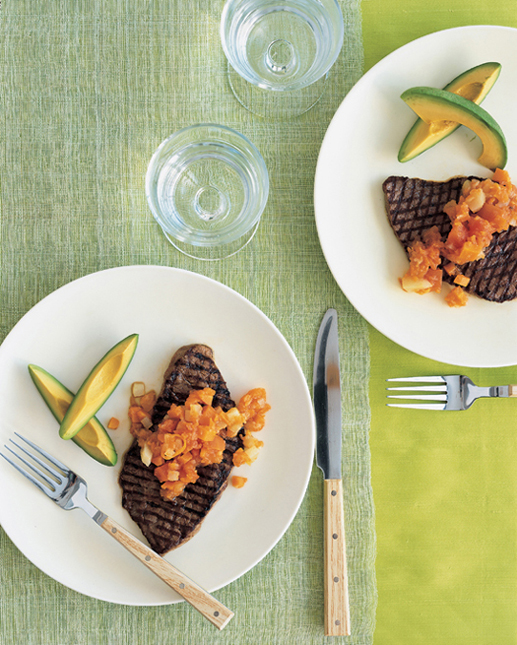
Steak with Spicy Papaya-Carrot Salsa

SERVES 4
A papaya salsa with fiery Scotch bonnet chiles makes a colorful—and spicy—condiment for grilled steak. The salsa also goes well with grilled fish, particularly snapper. For less heat, seed the chiles before slicing them.
Heat a grill (or grill pan) to medium high (if using a charcoal grill, coals are ready when you can hold your hand 5 inches above grate for just 4 to 5 seconds). Rub the steaks all over with the oil; season with ¼ teaspoon salt, dividing evenly, and pepper.
Grill steaks 1 to 2 minutes per side for medium-rare. Transfer steaks to four plates. Serve with avocado and salsa.
per serving: 343 calories; 3.6 g saturated fat; 10.3 g unsaturated fat; 92 mg cholesterol; 7.5 g carbohydrates; 41.8 g protein; 134.5 mg sodium; 3.8 g fiber
MAKES ABOUT 3 CUPS
Chayote is a member of the gourd family, along with cucumbers, melons, and squash; it is mild tasting, with a crisp, pearlike texture. It is often used in salads and salsas, or baked and stuffed, like other squash. If you can’t find one, you can substitute honeydew melon instead, adding it after the mixture has been cooked and allowed to cool.
¾ cup water
1 small chayote, peeled, seeded, and cut into ¼-inch dice
2 carrots, peeled and cut into ¼-inch dice
⅓ cup distilled white vinegar
1 or 2 fresh Scotch bonnet chiles, thinly sliced
1 teaspoon light brown sugar
Coarse salt
1 large papaya (Mexican or Solo, about 1 pound), peeled, halved lengthwise, seeds removed, and cut into ½-inch dice (2½ cups)
Bring the water, chayote, and carrots to a boil in a medium saucepan. Add vinegar, chiles, sugar, and 1 teaspoon salt. Return to a boil. Reduce heat; simmer, partially covered, until chayote and carrots are tender, 20 to 25 minutes, adding papaya after 10 minutes.
Remove from heat; let cool slightly. Process one-third of mixture in a food processor; return to saucepan, and stir to combine. Season with more salt, if desired. Salsa can be refrigerated up to 2 weeks in an airtight container; let cool completely before storing. Serve cold, at room temperature, or warm (reheat over medium).
per serving: 16 calories; 0 g saturated fat; 0 g unsaturated fat; 0 mg cholesterol; 3.7 g carbohydrates; .4 g protein; 7.4 mg sodium; 1 g fiber

Grass-Fed Beef Stir-Fry with Broccoli

SERVES 4
Grass-fed beef is leaner than beef raised on grain, which ultimately means it’s lower in saturated fat. Here, beef is served over red quinoa, which adds protein and vitamins to the dish. Brown rice is another healthful option.
2 teaspoons neutral-tasting oil, such as canola or safflower
3 garlic cloves, minced
1 tablespoon finely julienned peeled fresh ginger
Pinch crushed red pepper flakes
½ pound boneless sirloin or tenderloin, cut into thin strips
1½ cups chopped broccoli
2 tablespoons low-sodium tamari soy sauce
2 tablespoons fresh orange juice
Heat oil in a medium sauté pan over medium-high. Sauté garlic, ginger, and red pepper flakes until just golden, stirring frequently, about 1 minute. Increase heat to high, and add beef and broccoli. Cook until beef is seared and broccoli is crisp-tender, turning strips once, 2 to 3 minutes. Stir in tamari and orange juice. Serve immediately.
per serving: 163 calories; 3.6 g saturated fat; 6.1 g unsaturated fat; 31.2 mg cholesterol; 2.6 g carbohydrates; 13.1 g protein; 535 mg sodium; .4 g fiber